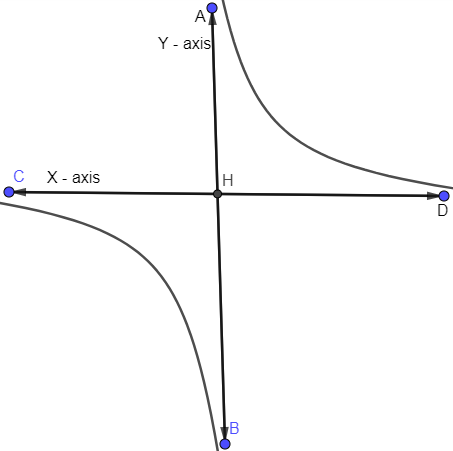Answer
368.7k+ views
Hint: We know that the transverse axis, conjugate axis and latus rectum are equal in length and it lies along $y=x$. Now, substitute the value of y from this equation to the given equation of hyperbola and find the coordinates of the latus rectum. Then using the distance formula, we are going to find the length of the latus rectum. Let us say, we have two points $\left( {{x}_{1}},{{y}_{1}} \right)\And \left( {{x}_{2}},{{y}_{2}} \right)$ and the distance between them is equal to $\sqrt{{{\left( {{x}_{2}}-{{x}_{1}} \right)}^{2}}+{{\left( {{y}_{2}}-{{y}_{1}} \right)}^{2}}}$.
Complete step by step answer:
The hyperbola given in the above problem is as follows:
$xy={{c}^{2}}$
Let us draw the hyperbola as follows:

Now, the transverse, conjugate axis and latus rectum all are equal and it lies along the straight line $y=x$.
Using the relation $y=x$ in the given hyperbola equation we get,
$xy={{c}^{2}}$
Substituting $y=x$ in the above equation we get,
$\begin{align}
& x\left( x \right)={{c}^{2}} \\
& \Rightarrow {{x}^{2}}={{c}^{2}} \\
\end{align}$
Subtracting ${{c}^{2}}$ on both the sides we get,
${{x}^{2}}-{{c}^{2}}=0$
We know the algebraic identity which says that: ${{a}^{2}}-{{b}^{2}}=\left( a-b \right)\left( a+b \right)$
Substituting $a=x\And b=c$ in the above equation we get,
${{x}^{2}}-{{c}^{2}}=\left( x-c \right)\left( x+c \right)$
Now, equating each of the brackets to 0 we get,
$\begin{align}
& x-c=0 \\
& \Rightarrow x=c; \\
& x+c=0 \\
& \Rightarrow x=-c \\
\end{align}$
From the above, we got two values of x as $\pm c$. Now, we are going to substitute these values of x in equation $y=x$ and we get,
$\begin{align}
& y=c; \\
& y=-c \\
\end{align}$
From the above, we got two points as $\left( c,c \right),\left( -c,-c \right)$. Let us name these points A and B respectively.
Now, we are going to find the distance between these two points using distance formula.
Let us say, we have two points $\left( {{x}_{1}},{{y}_{1}} \right)\And \left( {{x}_{2}},{{y}_{2}} \right)$ and the distance between them is equal to: $\sqrt{{{\left( {{x}_{2}}-{{x}_{1}} \right)}^{2}}+{{\left( {{y}_{2}}-{{y}_{1}} \right)}^{2}}}$
Substituting $\left( {{x}_{1}},{{y}_{1}} \right)=\left( c,c \right)$ and $\left( {{x}_{2}},{{y}_{2}} \right)=\left( -c,-c \right)$ in the above formula we get,
$\begin{align}
& \sqrt{{{\left( -c-c \right)}^{2}}+{{\left( -c-c \right)}^{2}}} \\
& =\sqrt{{{\left( -2c \right)}^{2}}+{{\left( -2c \right)}^{2}}} \\
& =\sqrt{4{{c}^{2}}+4{{c}^{2}}} \\
& =\sqrt{8{{c}^{2}}} \\
& =2\sqrt{2}c \\
\end{align}$
So, the correct answer is “Option c”.
Note: The mistake that could be possible in the above problem is that you might forget to consider the negative values while solving the quadratic equation in x so make sure you have properly solved the quadratic equation and hence, find the correct values of x.
Complete step by step answer:
The hyperbola given in the above problem is as follows:
$xy={{c}^{2}}$
Let us draw the hyperbola as follows:

Now, the transverse, conjugate axis and latus rectum all are equal and it lies along the straight line $y=x$.
Using the relation $y=x$ in the given hyperbola equation we get,
$xy={{c}^{2}}$
Substituting $y=x$ in the above equation we get,
$\begin{align}
& x\left( x \right)={{c}^{2}} \\
& \Rightarrow {{x}^{2}}={{c}^{2}} \\
\end{align}$
Subtracting ${{c}^{2}}$ on both the sides we get,
${{x}^{2}}-{{c}^{2}}=0$
We know the algebraic identity which says that: ${{a}^{2}}-{{b}^{2}}=\left( a-b \right)\left( a+b \right)$
Substituting $a=x\And b=c$ in the above equation we get,
${{x}^{2}}-{{c}^{2}}=\left( x-c \right)\left( x+c \right)$
Now, equating each of the brackets to 0 we get,
$\begin{align}
& x-c=0 \\
& \Rightarrow x=c; \\
& x+c=0 \\
& \Rightarrow x=-c \\
\end{align}$
From the above, we got two values of x as $\pm c$. Now, we are going to substitute these values of x in equation $y=x$ and we get,
$\begin{align}
& y=c; \\
& y=-c \\
\end{align}$
From the above, we got two points as $\left( c,c \right),\left( -c,-c \right)$. Let us name these points A and B respectively.
Now, we are going to find the distance between these two points using distance formula.
Let us say, we have two points $\left( {{x}_{1}},{{y}_{1}} \right)\And \left( {{x}_{2}},{{y}_{2}} \right)$ and the distance between them is equal to: $\sqrt{{{\left( {{x}_{2}}-{{x}_{1}} \right)}^{2}}+{{\left( {{y}_{2}}-{{y}_{1}} \right)}^{2}}}$
Substituting $\left( {{x}_{1}},{{y}_{1}} \right)=\left( c,c \right)$ and $\left( {{x}_{2}},{{y}_{2}} \right)=\left( -c,-c \right)$ in the above formula we get,
$\begin{align}
& \sqrt{{{\left( -c-c \right)}^{2}}+{{\left( -c-c \right)}^{2}}} \\
& =\sqrt{{{\left( -2c \right)}^{2}}+{{\left( -2c \right)}^{2}}} \\
& =\sqrt{4{{c}^{2}}+4{{c}^{2}}} \\
& =\sqrt{8{{c}^{2}}} \\
& =2\sqrt{2}c \\
\end{align}$
So, the correct answer is “Option c”.
Note: The mistake that could be possible in the above problem is that you might forget to consider the negative values while solving the quadratic equation in x so make sure you have properly solved the quadratic equation and hence, find the correct values of x.
Recently Updated Pages
Mark and label the given geoinformation on the outline class 11 social science CBSE

When people say No pun intended what does that mea class 8 english CBSE

Name the states which share their boundary with Indias class 9 social science CBSE

Give an account of the Northern Plains of India class 9 social science CBSE

Change the following sentences into negative and interrogative class 10 english CBSE

Advantages and disadvantages of science

Trending doubts
Which are the Top 10 Largest Countries of the World?

Difference between Prokaryotic cell and Eukaryotic class 11 biology CBSE

Differentiate between homogeneous and heterogeneous class 12 chemistry CBSE

Fill the blanks with the suitable prepositions 1 The class 9 english CBSE

Give 10 examples for herbs , shrubs , climbers , creepers

Write a letter to the principal requesting him to grant class 10 english CBSE

How do you graph the function fx 4x class 9 maths CBSE

The Equation xxx + 2 is Satisfied when x is Equal to Class 10 Maths

10 examples of evaporation in daily life with explanations



